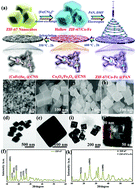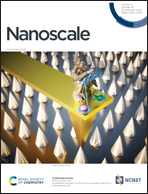Construction of series-wound architectures composed of metal–organic framework-derived hetero-(CoFe)Se2 hollow nanocubes confined into a flexible carbon skeleton as a durable sodium storage anode†
Abstract
Metal chalcogenides with structural pulverization/degradation and intrinsic low electrical conductivity trigger the challenging issues of serious capacity fading and inferior rate capability upon repeated de-/sodiation cycling. Multiple electroactive heterostructures can integrate the inherent advantages of a strong synergistic coupling effect to improve their electrochemical Na+-storage behavior and structural durability, showing robust mechanical features, fast Na+ immigration and abundant active insertion sites at intriguing heterointerfaces. Hence, a series-wound architecture of metal–organic framework (MOF)-derived heterogeneous (CoFe)Se2 hollow nanocubes confined into a one-dimension carbon nanofiber skeleton ((CoFe)Se2@CNS) was successfully developed via a template-assisted liquid phase anion exchange followed by electrospinning and conventional selenization treatment. When examined as an anode for sodium ion batteries, the (CoFe)Se2@CNS electrode exhibits remarkably enhanced electrochemical Na+-storage performance delivering a high sodiation capacity as high as 213.9 mA h g−1 after 3650 cycles at 5 A g−1 with a capacity degradation rate of only 0.0047% per cycle; specifically, it shows tremendous rate performance and ultrastable cycling durability of 194.7 mA h g−1 at a high rate of 8 A g−1 after 5630 cycles. This work can shed light on a fundamental approach for designing heterostructures of multiple electroactive components toward high-performance alkali metal ion batteries.



 Please wait while we load your content...
Please wait while we load your content...